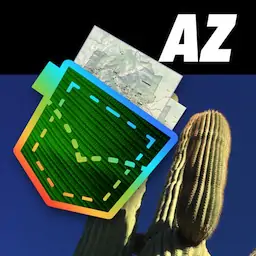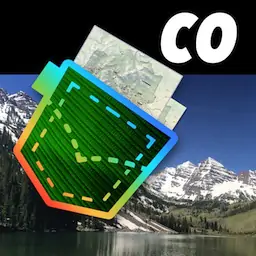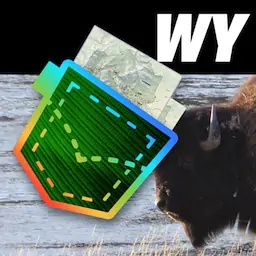Nebraska and ColoradoNHT Auto Tour Guides |
The National Historic Trail route from Nebraska through Northeastern Colorado. Published by the National Park Service (NPS).
featured in
covered parks
National Trails System
National Park Service
U.S. Department of the Interior
National Historic Trails
Auto Tour Route Interpretive Guide
Nebraska and Northeastern Colorado
“Approaching Chimney
Rock”
By William Henry Jackson
Chimney Rock, in western Nebraska, was one of the most notable
landmarks recorded in emigrant diaries and journals. Photograph is
courtesy of The Wagner Perspective.
NATIONAL HISTORIC TRAILS
AUTO TOUR ROUTE INTERPRETIVE
GUIDE
Nebraska and Northeastern Colorado
Prepared by
National Park Service
National Trails System—Intermountain Region
324 South State Street, Suite 200
Box 30
Salt Lake City, Utah 84111
Telephone: 801-741-1012
www.nps.gov/cali
www.nps.gov/oreg
www.nps.gov/mopi
www.nps.gov/poex
NATIONAL PARK SERVICE
DEPARTMENT OF THE INTERIOR
August 2006
Contents
Introduction • • • • • • •
1
The Great Platte River Road • • • • • • •
From Path to Highway • • • • • • •
“A Whiz and a Hail” — The Pony Express • • • • •
A “Frayed Rope” • • • • • • •
The Platte Experience • • • • • • •
Natives and Newcomers: A Gathering Storm • • • • • • •
War on the Oregon & California Trails • • • • • • •
Corridor to Destiny • • • • • • •
2
4
8
11
15
18
21
24
SITES AND POINTS OF INTEREST • • • • • • •
Auto Tour Segment A:
Odell to Kearney • • • • • • •
Auto Tour Segment B:
Omaha-Central City-Kearney • • • • • •
Auto Tour Segment C:
Nebraska City-Central City-Kearney • • • • • • •
Auto Tour Segment D:
Kearney to Wyoming Border • • • • • • •
25
For More Information • • • • • • •
61
Regional Map • • • • • • •
26
35
41
43
inside the back cover
Auto Tour Route Interpretive Guide
Nebraska
Introduction
M
any of the pioneer trails and other
historic routes that are important in
our nation’s past have been designated by
Congress as National Historic Trails. While
Auto Tour
most of those old roads and routes are
Route
not open to motorized traffic, people can
drive along modern highways that lie close
to the original trails. Those modern roads
are designated as Auto Tour Routes, and they are marked with highway
signs and trail logos to help today’s travelers follow the trails used by the
pioneers who helped to open a new nation.
This interpretive publication guides visitors along the Auto Tour Routes
for the Oregon, California, Mormon Pioneer, and Pony Express National
Historic Trails as they approach and parallel the Platte River across
Nebraska and cut across the northeastern corner of Colorado. Siteby-site driving directions are included, and an overview map is located
inside the back cover. To make the tour more meaningful, this guide also
provides an historical overview of the four trails, shares the thoughts and
experiences of emigrants who followed those routes, and describes how
the westward expansion impacted native peoples of the Great Plains.
Individual Auto Tour Route interpretive guides such as this one are in
preparation for each state through which the trails pass. In addition,
individual National Park Service interpretive brochures for the Oregon,
California, Mormon Pioneer, and Pony Express National Historic Trails
are available at many trail-related venues, and can be requested from
the National Trails System Office at 324 South State, Suite 200, Box
30, Salt Lake City, Utah 84111. These brochures provide more detailed
information about each of the trails. Additional information on each trail
also can be found on individual trail web sites. Links are listed on the title
page of this guide.
1
Auto Tour Route Interpretive Guide
Nebraska
The Great Platte River Road
“Too thick to drink, too thin to plow, too pale to paint.” “A mile wide and
an inch deep.” “A stream flowing upside down.”
C
overed wagon pioneers of the 19th century liked to joke about
Nebraska’s Platte River, a stream unlike any they had known back
East. But the Platte, strange as it looked, was no joke. A summer shower
could send it raging over-bank and through camp; its soft quicksand
bottom could swallow up an ox team. River crossings were ordeals to
dread.
The river’s setting, too, seemed strange. Surrounding prairie, frequently
cleansed by wildfire, was burned bare of trees right up to the water’s
edge, and a line of low sand hills, looking like a storm-wracked beach,
rimmed much of the river valley.
Yet the yellow Platte, that treeless “Coast of Nebraska,” was an emigrant’s
lifeline—a water source that snaked 800 dusty miles between the
Missouri River and the uplands of central Wyoming.
Though a choked and sandy disappointment of a stream, the Platte
always was and still is a natural east-west corridor across the central
plains. Migrating game and moccasin-clad feet wore paths through the
“Fort Kearny & the South Platte River”
by William Henry Jackson.
2
Auto Tour Route Interpretive Guide
Nebraska
valley thousands of years before any white man ventured there. Like
those first travelers, covered wagon emigrants and their slow, plodding
oxen found water, grass, and fuel along the river. They also found the
valley floor to be fairly level and smooth, a fine setting for roads in the
21st century as well as the 19th. When you drive the riverside routes of
today’s Highways 26, 30, and I-80 across Nebraska, you are following
the footsteps of native explorers, hunters, traders, and fighters, and of
mountain men, soldiers, and countless pioneers.
This broad highway along the Platte River was known in the 19th century
by a variety of names, depending on a traveler’s purpose and destination.
Some native peoples called it the Great Medicine Road; other travelers
called it the Oregon Trail, the Mormon Trail, the Pony Express Route or
the California Road.
But taken all together, the footpaths and wagon ruts that flanked the
roiling, yellow Platte into Wyoming now have one name in common: The
Great Platte River Road.
[The Platte River] was fearful to look at, - rushing and boiling and
yellow with mud, a mile wide, and in many places of unknown
depth. The bed was of quicksand – this was the worst difficulty.
— Margaret A. Frink, emigration of 1850
“Buffalo Stampede” along the South
Platte River by William Henry Jackson.
3
Auto Tour Route Interpretive Guide
Nebraska
From Path to Highway
S
upply caravans hauling supplies to the annual fur trappers’
Rendezvous began following Indian paths along the Platte River and
into the Rocky Mountains in the 1820s. Their pack trains and wagons
wore rough tracks, or “traces,” along both sides of the river across
Nebraska and up the North Platte into Wyoming. In May 1840, as the
profitable fur trade in beaver pelts drew to an end, emigrants Joel and
Mary Walker took four children and two wagons to join up with the last
supply caravan leaving Independence, Missouri, for the final “Trappers’
Rendezvous.” From the Rendezvous site in western Wyoming, the
Walker family continued westward with, a group of missionaries and
trappers, reaching Oregon’s Willamette Valley in mid-September. They
were the first emigrant family to cross the continent on what would
become the Oregon Trail, and their trek marks the beginning of the
overland emigration era.
In 1841, the first full wagon train of west bound settlers, known to history
as the Bidwell-Bartleson Party, headed up the Platte. More wagons set
out the following spring, and the next, and the next, gradually beating
a well-defined wagon road along the south side of the river and into
the Rockies. Maps of the emerging emigrant trails were published
in 1843 and 1845 government reports prepared by explorer John C.
Fremont, who was delighted to encounter pioneers using his work to
guide them west. Fremont’s mapping expeditions for the U.S. Corps of
Topographical Engineers made him a national hero, and the dashing
young officer inspired many Americans to start across the Nebraska
prairie.
The neglected old teamsters’ trace along the Platte’s north bank was
revived in 1847, when a purposeful party of Latter-day Saints (Mormons)
began developing its own road, apart from the main Oregon and
California migrations. Thus began a distinct and separate current of the
westward overland movement along Nebraska’s Platte River.
After years of conflict with anti-Mormons across several states, church
leaders decided to move their people West to live and govern themselves
according to their beliefs. Church President Brigham Young led the
first phase of the Mormon emigration from Nauvoo, Illinois, to Winter
Quarters (Omaha), Nebraska, in 1846. (The Nauvoo-to-Omaha trek is
described in the Auto Tour Route Interpretive Guide for the Mormon
Pioneer National Historic Trail Across Iowa.)
4
Auto Tour Route Interpretive Guide
Nebraska
Mud and hardship dogged the Latter-day Saints across Iowa in 1846,
leaving them exhausted, sick, and hungry by the time they reached the
Missouri River. Unable to go on, the Mormon pioneers built temporary
shelters and settled in for the coming winter. At Winter Quarters and
scattered settlements in Nebraska and across Iowa, more than 700
Mormon emigrants perished from exposure, malnutrition, and disease
over the winter of 1846-47.
During those brutal months, Brigham Young and his advisers prepared
carefully for the final push over the Rocky Mountains, studying maps
and reports and gathering equipment and supplies. Young left Winter
Quarters in mid-April 1847 with a handpicked company of 143 young
men, three women, and two children. For safety and efficiency, the group
formed two large divisions, which were later divided into companies
of fifty and ten. This well-disciplined lead party would trek across the
prairie and through the mountains to the Valley of the Great Salt Lake to
begin preparing a place for the thousands of faithful to follow during the
coming summer.
…we found that the River we had seen in the distance was none
other than the celebrated “Platte,” the highway of our future
journey, which caused joy & rejoicing in my Soul… —Thomas
Bullock, 1847 Mormon emigration
Keeping to the north side of the Platte River was key to Young’s
emigration plan. The trail along the south bank would be easier and
grass for the cattle seemed to grow thicker there, but the Mormon leader
wanted to avoid further clashes with anti-Mormons who might be
emigrating along the Oregon and California road. Young’s north-bank
trail remained the primary route taken during the ongoing “Gathering of
Zion” that spanned the next two decades, although many later Mormon
parties did follow the Oregon-California Trail on the south side of the
valley, instead.
Despite a tense encounter with Omaha Indians, the loss of two horses
to Pawnees, and a prairie fire that forced the travelers to seek safety
on a Platte River island, the Nebraska leg of the 1847 Mormon journey
went smoothly. Along the way, Young’s party improved the road, set up
trail markers every 10 miles, built ferries, and measured and made notes
of the route to aid those who would follow. When the first Mormon
wagons arrived in the Valley of the Great Salt Lake on July 23, 1847, the
tired travelers immediately began breaking ground to plant potatoes
5
Auto Tour Route Interpretive Guide
Nebraska
and turnips. Over 2,000 Latter-day Saints were expected to arrive in the
valley that summer. They would need food to survive the winter.
In the spring of 1848, a third company of nearly 2,500 Mormon emigrants
set out along the Mormon Trail across Nebraska and Wyoming to the
settlement that would become Salt Lake City. Although the Mormons
abandoned Winter Quarters at that time, later Mormon emigrants would
continue to “jump off” at Missouri River crossings near today’s Council
Bluffs/Omaha through early the 1870s.
Brigham Young’s hope of keeping Mormon emigrants safely segregated
from other travelers was soon disappointed, though. Discovery of gold
in California in 1848 opened the floodgates of emigration the following
spring, when tens of thousands of men and women, the “49ers,” rushed
westward along both sides of the Platte River.
…When we left the Missouri River we followed the Platte. And we
killed rattle snakes by the cord in some places; and made roads and
built bridges til our backs ached. —Church President Brigham
Young, 1868
For an indefinite number of miles there seemed to be an unending
stream of emigrant trains….It was a sight which, once seen, can
never be forgotten; it seemed as if the whole family of man had set
its face westward. — William G. Johnston, emigration of 1849
It was alarming to see the long strings of wagons that were on the
road….It would appear from the sight befor us that the Nation was
disgorgeing its self and sending off its whole inhabitance.— James
Pritchard, emigration of 1849
6
Auto Tour Route Interpretive Guide
Nebraska
G
old-seekers swarmed the trailheads, or “jumping-off places,”
in the spring of 1849. They competed in frenzy for oxen, gear,
and supplies, and those without wagons or draft animals set out on
horseback or on foot —some even pushing wheelbarrows—to find
their fortunes in California. The 49ers stampeded up the trails, mobbed
the established river fords and ferries, and crowded into trailside
campgrounds. Their livestock stripped the corridor of grass, and starving
oxen dropped dying in their yokes. Travelers abandoned dead animals,
extra food, all sorts of belongings, and sometimes even their wagons,
turning the Platte River Valley into a long, stinking junkyard. The trail
also became a cemetery: cholera, a deadly intestinal disease spread by
contaminated water, raced the 49ers up the Platte, taking hundreds,
maybe thousands, of victims to their graves.
Oh! The sacrifice of wagons, clothing, fire arms, beds, bedding,
Buffalo skins, trunks, chests, harnesses, and in the loss of life. The
road to gold is strewed with destruction, wretchedness and woe; and
yet, thousands and tens of thousands follow on in the way with the
hope of securing the wealth of this world. —Orson Hyde, Mormon
emigration of 1850
Despite these troubles, some 25,000 Americans went West in 1849—more
than the previous nine years combined! The next year, nearly 50,000
souls set feet and face toward the Pacific, lured by the hope of riches in
California and the promise of prime farmland in Oregon. The flow of
emigration peaked in 1852 when some 60,000 people hit the trails, and
then continued in fits and starts—surging during economic hard times
and during later Western gold and silver rushes, and dwindling when
wars loomed.
The one-time Indian footpath had become a permanent highway, with
the Platte River for a centerline.
The trail was nearly a quarter of a mile wide- that is, a row of
wagons fifteen-hundred feet across, and extending in front and
to the rear, as far as we could see…a vast sea of white flapping
wagon covers, and a seething mass of plodding animals.—John K.
Stockton, emigration of 1852
7
Auto Tour Route Interpretive Guide
Nebraska
“A Whiz and a Hail” — The Pony Express
A
dding another strand to the twisted braid of trail along the Platte was
a crack team of young saddle-toughs who carried mail across the
continent for the Pony Express.
The Pony Express was a cross-country relay of horses and riders
carrying letters and dispatches in both directions between St. Joseph,
Missouri, and San Francisco, California. In those pre-telephone, pretelegraph days, news going to California via regular mail could take up
to six months to arrive. For a premium fee (about $85 per half-ounce
in today’s money), “the Pony” could deliver that letter in ten to sixteen
days, depending on weather conditions.
This was a private business venture launched in 1860 by partners William
Russell, William Waddell, and Alexander Majors, who together also ran a
freighting operation out of Nebraska City. Hoping for a profitable federal
mail-delivery contract, the partners established a string of stations across
the West, stocked them with fast, hardy horses, and hired around eighty
skilled riders to relay the mail between stations. Each rider would carry
the mail pouch (called a mochilla) along his leg of the route, thrilling
emigrants and stagecoach passengers with a “whiz and a hail” as he
galloped past them.
Driving slow oxen seemed pretty tame compared with jumping
on spirited ponies and going full tilt along the old trail, past the
emigrant trains and freight outfits, or even bands of Indians.
—William Campbell, Pony rider in Nebraska
The Pony Express riders would head out with the post as soon as they
received the mochilla, any time of the day or night and in all weather.
Pony Expressman Richard Cleve rode seventy-five miles across eastern
Nebraska through a raging blizzard, only to find that his relief rider
at the next station was too sick to sit his horse. Cleve remounted and
floundered on through whiteout conditions, snowdrifts, and sub-zero
temperatures for another seventy-five miles. Man and horse stumbled
into their final station after thirty-six hours on the trail. Other riders
completed similar death-defying runs, and stories of their bravery and
endurance were repeated across the nation.
8
Auto Tour Route Interpretive Guide
Nebraska
I…found it impossible to find the road. I would get off the horse and
look for the road, find it and mount the horse, but in five yards I
would lose it again.—Pony Express Rider Richard Cleve
Despite their one-time celebrity, those riders are known to few today.
Only two names still loom above the unsettled dust of Pony history:
James Butler “Wild Bill” Hickok and William “Buffalo Bill” Cody. Hickok
was a Pony Express stock-tender at Rock Creek Station, Nebraska,
where he launched his career as a gunslinger in a brutal shootout over a
Pony Express business debt. Cody, on the other hand, was a showman
who told exciting tales about his adventures as a teenage Pony Express
rider, and even re-enacted those events in his touring Wild West show.
His stories seem unlikely, though, and it is doubtful that Cody ever
worked for the Pony at all. Accurate or not, Buffalo Bill’s Wild West
performances captured the spirit of the Pony and branded its legend
deep into the nation’s identity.
These days it is hard to separate truth from the myth of the Pony
Express. The enterprise was so short-lived that it left little in the way of
business records, and most of those – letters, receipts, payroll logs, etc. –
have disappeared. History is further muddled by romanticized accounts,
faulty memories, and outright hoaxes. Researchers today disagree on
who was the first rider to leave St. Joseph with the first mochilla full of
mail, and where exactly he left from, and whether he ended his trip in
Sacramento or San Francisco. Students of the Pony debate trail routes,
argue the authenticity of “original Pony Express stations,” and even
“Pony Express Rider Chased by
Indians”
by William Henry Jackson
9
Auto Tour Route Interpretive Guide
Nebraska
wonder if some Pony riders were women disguised as boys. Serious
researchers are still sifting through the lore, sorting sweet fables from
sweaty reality and discovering long-lost nuggets of factual Pony history.
But this much is sure: The Pony Express ran its owners into scandalous
financial ruin within 18 short months. The operation quickly racked up
expenses while the hoped-for government contract shyly stayed beyond
reach. Completion of the transcontinental telegraph system on October
26, 1861, made the debt-ridden Pony obsolete. Riders finished their last
run on November 20, 1861.
Ere long, the “Pony Express” must give place to the telegraph, and
not many years can elapse before the Pacific Railroad will supersede
the overland express to California. —George Ellis Baker, 1860
Completion of the transcontinental telegraph system on October 26, 1861, made the Pony
Express obsolete. Illustration is courtesy of the Library of Congress from Harpers Weekly.
10
Auto Tour Route Interpretive Guide
Nebraska
A “Frayed Rope”
T
he Great Platte River Road was no neatly engineered lane where
prairie schooners rolled prettily in single file, but an evolving, rowdy
free-for-all of multiple ruts scoring the river valley. Traffic went both
ways as emigrants, commercial freight caravans, stagecoaches, and postal
relay riders moved back and forth between East and West. New tracks
were created as ox-drawn wagons and mule trains passed each other and
spread out three, six, or more abreast to escape the choking dust kicked
up by those ahead. New cutoffs were developed as travelers sought out
the shortest, safest, and fastest ways into and through the Platte River
Valley.
On maps, the road’s eastern end took on the appearance of a frayed
rope, with strands funneling traffic into the Platte Valley from numerous
“jumping off places” along the Missouri River. Several strands of the
rope brought overland traffic from the southern departure points at
Independence, Westport, Kansas City, Leavenworth, Atchison, St.
Joseph, and Amazonia. These feeder routes, heavily used in the early
years of the migration, led across northeastern Kansas and into the
valley of the Little Blue River. The main trail followed that stream
northwestward into Nebraska, crested a 20-mile-wide divide, and then
dropped to the Platte.
“Crossing the Missouri” by William
Henry Jackson
11
Auto Tour Route Interpretive Guide
Nebraska
More strands of trail led directly into the Platte Valley from Omaha/
Council Bluffs, Bellevue, Plattsmouth, Old Wyoming, Minersville,
Nebraska City, and other northern “jumping off places.” By the early
1850s, most emigrant traffic set out from the northern Missouri River
ports, cutting off nearly 200 miles of overland travel across Kansas.
Commercial and military traffic, much of it from St. Joseph and Fort
Leavenworth, continued to use the Kansas feeder routes into the Platte
Valley.
Parties setting out from Council Bluffs and Omaha on the Mormon Trail
(also called the Council Bluffs Road) north of the Platte had to ford the
Elkhorn and Loup Rivers and cross some broken country, but overall
found easy traveling. Where the river forks near today’s city of North
Platte, those travelers kept to the north, following the Mormon route
along the North Platte River into today’s Wyoming.
. . . You would be surprised to see the ways of travel. Large trains
of carts with one ox on a cart, some wagons with 8 yoke, wile go
hundred horse teams, mule teams, sail wagons goes by wind and
steam wagons and hand carts and whele barrows. So wags the tide
of life. —Squire Lamb, Nebraska stage station operator, 1862
Trail strands coming into the south side of the Platte Valley braided
together into a single main road just east of Fort Kearny, a military
“Sand Hills of the Platte River” by
William Henry Jackson.
12
Auto Tour Route Interpretive Guide
Nebraska
outpost established in 1848 to aid the Oregon emigration. South-side
travelers continued from Fort Kearny along mostly smooth and level
terrain to the confluence of the North and South Platte Rivers. Some
parties crossed to the north bank of the South Platte somewhere near
the confluence, but most continued on the south side to O’Fallon’s Bluff.
That three-mile-long obstacle at the river’s edge forced wagons up and
over the bluff, where they wore ruts that are still visible today.
[The sand hills are] broken into separate and rugged peaks and
elevations, like some gigantic ocean breaker dashing its immense
volume into a hundred different waves. —James Meline,
emigration of 1866
From O’Fallon’s Bluff, travelers continued along the South Platte a short
distance to one of several river fords. There, wagons could cross over
to the North Platte and follow its south bank—paralleling the Mormon
Trail on the opposite side—to Fort Laramie. Two of these South Platte
crossings forced wagons on a steep, difficult climb up California Hill and
then a steep, dangerous drop down Windlass Hill—and all three routes
dipped into pleasant Ash Hollow, where the unwary sometimes were
confronted by Indians. By 1860, most travelers, including Pony Express
riders, avoided those hazards by following the South Platte all the way
to Julesburg, Colorado, and then cutting northwest to rejoin the Great
Platte River Road near Courthouse Rock.
“Through Mitchell Pass” at Scott’s
Bluff by William Henry Jackson
13
Auto Tour Route Interpretive Guide
Nebraska
From Courthouse Rock, the south-bank road continued northwest
toward the spectacular spire of Chimney Rock, the most famous
landmark on the combined emigrant trails. The route then went around
(later, through) Scotts Bluff before continuing into Wyoming. Many
travelers paused to explore, sketch, and carve their names into these
features. Those following the Mormon Trail on the north side of the river
also could see Courthouse Rock, Chimney Rock, and Scotts Bluff, and
often described them in their journals.
“Old Fort Mitchell” near Scotts Bluff by
William Henry Jackson.
14
Auto Tour Route Interpretive Guide
Nebraska
The Platte Experience
O
toe Indians called this region “Nebrathka,” meaning “flat water,”
and the French word “Platte” means the same. The defining flatness
of the broad Platte River Valley, which averages five to seven miles wide,
made it ideal for animal-powered travel on both sides of the stream.
Besides being “good wheeling,” the long Platte River stretch of trail
also provided plenty of water and native grasses for game and livestock.
Many emigrants later recalled it as the easiest, most pleasant part of their
westering journey.
…As prity a rode as I ever saw….it is level and smooth as a plank
floor. —Dr. A. H. Thomasson, emigration of 1850
We traveled through the most level plains I ever saw in my life.
Here is such a scenery of beauty as is seldom witnessed. — Joseph
Williams, circa 1842
The sight of a tree is out of the question. It is seldom we see so mutch
as a bush.—Levi Jackman, Mormon emigration of 1847
North or south of the Platte, travelers shared similar experiences. Some
were delighted by the open, treeless expanse while others were dismayed
by it. Many wrote of the flowers, animals, sand hills, and rock formations
they encountered along the trail. Nearly everyone complained about the
dirty water, the quicksand, and the swarming, biting insects. Most were
thrilled by their first sighting of bison and their first taste of buffalo steak,
but not so happy about having to collect and cook over “buffalo chips”
due to the scarcity of firewood.
Bison, or American buffalo, had been hunted out of their range in the
eastern United States by the early 1800s. In the first decades of the
emigration, Easterners saw their first buffalo along the Platte in vast
numbers, herds of thousands and tens of thousands that covered the
plains like a brown, woolly blanket. The massive herds sometimes
blocked wagon trains for miles, and occasionally charged through
a wagon train or trail side camp, frightening livestock and wrecking
wagons. Professional buffalo hunters slaughtered bison to sell their
hides for industrial uses, soldiers killed them to provision their forts, and
emigrants shot them for food as well as sport. By the early 1860s, travelers
saw few buffalo in the Platte River Valley.
15
Auto Tour Route Interpretive Guide
Nebraska
Plains wildlife, natural beauty, and minor complaints aside, trudging in
the choking dust with ox-team and wagon under the hot Nebraska sun
was no picnic. Many noted in their journals the furious storms that raged
over the plains, stampeding livestock and terrifying travelers—even
killing some. People died from accidental gunshot, slipping under
wagon wheels, injuries caused by unruly oxen, drowning during a stream
crossing, and from complications of pregnancy and childbirth. Cholera
took many lives, leaving single parents to carry on alone, hundreds of
miles from home, with a wagonload of youngsters—or worse, leaving
frightened orphans to depend on the kindness of strangers. Many of the
dead were buried in unmarked graves on the wagon trail itself, in hopes
that neither wolves or Indians would rob their final resting place.
The [buffalo] dung was thick in most places, and like chips and
score blocks – for this and the sake of softening a hard word they go
by the name of Buffalo chips. —Oliver Boardman Huntington,
Mormon emigration of 1847
There came up a storm in the afternoon. The wind blew very hard
and on the opposite side of the river a tremendous hurricane. We
saw trees flying on the air and water blown out of the River as high
apparently as the clouds. —James John, emigration of 1841
. . . instead of a single fork or chain [of lightning] a dozen would
burst from the dark mass & rush in every direction like serpents
from a rocket….at times the whole heavens would appear to be as
a blaze for several seconds during which time the minutest object
could be discovered. —William Henry Tappan, civilian draftsman
at Fort Childs (Fort Kearny), June 1848
The team behind us stop[ped] in mid-stream…and the treacherous
sand gave way under their feet. They sank slowly, gradually, but
surely. They went out of sight inch by inch, as the water rose over
the moaning beasts. Without a struggle they disappeared beneath
the surface. In a little while the broad South Platte swept on its
way, sunny, sparkling, placid, without a ripple to mark where a
lonely man parted with all his fortune. —Luzena Stanley Wilson,
emigration of 1849
Indians were a huge worry for many travelers, though for the most
part emigrant encounters with Native Americans on the trails across
16
Auto Tour Route Interpretive Guide
Nebraska
Nebraska were peaceful, even enjoyable. In the early years of the
emigration, in particular, native people viewed the “Great Medicine
Road” as a kind of grand market where they could trade for goods and
visit with travelers. Emigrants and Indians, including the much feared
Pawnees, exchanged many acts of personal kindness; and the Sioux, who
controlled most of the Platte River Valley, allowed the wagons to pass in
peace.
Still, most emigrants entered Indian Country expecting the worst. Their
fears of Indian attack were fueled by rumors, hoaxes, and lurid halftruths in newspapers and popular books—but also by a long history of
very real, very violent Indian and settler conflicts in the East. Rumor,
history, and experience likewise gave native Plains people reason to be
wary of white Americans. When the first great flood of humanity and
beasts rushed up the Platte Valley in 1849, stripping the countryside of
grass and driving off the buffalo and other wild game, that wariness
began to turn to resentment.
“Teepees on the Plains” Lantern Slide by Walter McClintock. Image
is courtesy of the Beinecke Rare Book & Manuscript Library, Yale
University.
17
Auto Tour Route Interpretive Guide
Nebraska
Natives and Newcomers: A Gathering Storm
A
s American settlers surged westward across the eastern woodlands
and prairies in the early 19th century, they pushed Native
Americans out of their ancestral homes. The U.S. government resettled
many of those displaced Eastern tribes—the Kickapoos, Delawares,
Pottawatomies, and others—in congressionally designated Indian
Territory west of the Missouri River and south of the Platte. The
resettled Eastern tribes were among the first Indians encountered by
emigrants passing through northeastern Kansas.
Settlements for the Eastern tribes were carved out of territories already
occupied by the Kanza, Otoe, Missouria, Osage, Pawnee, and other
Missouri River tribes. Those groups, in turn, were forced to move, giving
over their traditional hunting grounds and village sites to the Eastern
groups. Their relocation often put them closer to enemies such as the
Cheyenne and Sioux, powerful Indian nations that had moved out onto
the Nebraska plains from their eastern woodland and prairie homelands.
The Pawnees of northern Kansas and east-central Nebraska were one of
many tribes displaced by white settlement. Pawnees were settled village
dwellers who lived in earth-lodges,













